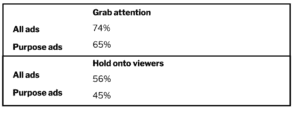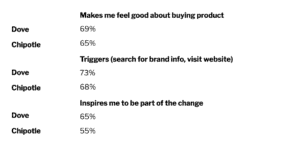We’re witnessing a purpose-fatigue – so what’s the way forward? How can brands better inspire action? Inspired by my book The Hero Trap and its framing around transformative brands and the methodology the Arrow, I’ve embarked on a research with research experts GfK to better understand what works – and what doesn’t!
We have very little time to act on the climate emergency and at the same time a lot of the negative impact from companies are in fact in the hands of people for example washing detergent using water and energy. And lastly, if we’re to understand the business case behind purpose, we need to understand how we can help people cross the intent to action gap – and inspire them to choose better!
“Purpose marketing represents billion-dollar investment for brands — so these campaigns need to meet high standards,” observed Eric Villain, Managing Director Marketing Effectiveness GfK North America.
With millions of dollars being spent to define and promote the “purposes” of brands, what are the real outcomes? The first findings from The Purpose Impact Monitor – a new, ongoing study developed by Goodvertising Agency in association with GfK – show that brand purpose ads generally underperform mainstream ads when it comes to grabbing and holding viewers’ attention.
While three-quarters of generic ads were able to capture attention, the proportion dropped to two-thirds for purpose ads. And while more than half of mainstream ads kept viewers engaged, the figure was 11 points lower for purpose creatives.
Purpose ads challenged on breaking through and holding attention

The study also compared two types of purpose creatives –
- traditional purpose ads, in which the brand presents itself as the hero, and
- “transformational” purpose ads, which put the spotlight on what consumers can and do accomplish.
The new research showed that transformational ads performed best when it came to delivering a clear message. Nearly half (48%) of transformational ad viewers reported that the message was clear, compared to just one-third (33%) for mainstream ads and 43% for traditional purpose spots.
Transformative ads better at delivering a clear message!

One telling contrast can be seen in purpose spots from Dove (“Reverse Selfie”) and Chipotle (“Can a Burrito Change the World?”).
Chipotle: Can a burrito change the world?
Dove: Reverse selfie
The former takes a transformational approach, showing what it takes to push back on the pressure girls feel to look perfect on social media, while Chipotle’s is a classic purpose spot focusing on the product itself. While diagnostics for the two were similar in some ways, Dove scored significantly higher (+10%) on the action part such as “inspires me to be part of the change.” Or triggers such as “I want to learn more about the brand or the product” (+5%)
Transformative brands better at inspiring action

“I’ve been in the purpose space for more than a decade,” said Kolster, “and there’s no doubt it is increasingly difficult to cut through with a classic purpose angle – ‘We care!’ It’s time brands stop pitching themselves as the heroes and instead turn people into the heroes. When brands help people become healthier or greener, consumers can feel the difference; it is not just another grandiose brand claim.”
Believe in people, and they’ll believe in themselves
Unless you as a brand focus and plan your efforts, and your entire brand for that matter, on enabling people’s transformation, you can’t be surprised if their intentions don’t convert to sales. My experience is that most brands find it difficult to identify that insight or create that stringent focus: I often hear as an excuse, “Our brand appeals to everyone.” I would argue you can truly touch everyone only if you begin with someone because the danger is that, when you try to appeal to everyone, you appeal to no one.
When you as a brand is on a mission to transform people’s lives at every step, your resources, thinking and activity bring you closer to enabling people and ultimately changing behaviours and driving sales. Take the mindful running company District Vision: their transformative promise is to get more runners to become mindful. Part of the customer journey is to join classes, get inspired in the store, which eventually leads to buying District’s products, which leads to profit. District Vision has a strong growth case to suggest so. It’s a win–win for company and people.
People’s expectations are getting higher every day. Reports, certificates and glossy marketing campaigns won’t cut it any more. This is not a race for transparency, it’s not a race to being better, but a race to make a meaningful difference in people’s lives. The idea of a consumer defined only by buying is giving way to a new role where it’s all about better living or self-actualisation. From having worked on behaviour change campaigns targeting alcoholics, I know that the only thing they need is someone who believes in them. Someone who believes that they can change, when they often have given up hope themselves. It’s worth helping people help themselves. Your brand is no greater than what you can make people achieve. As the reseach hits, the rewards are plentiful for both brand and people. It’s time to evolve purpose!
GfK. Growth from Knowledge.
For over 85 years, we have earned the trust of our clients around the world by supporting them in business-critical decision-making processes around consumers, markets, brands, and media. Our reliable data and insights, together with advanced AI capabilities, have revolutionized access to real-time, actionable recommendations that drive marketing, sales and organizational effectiveness of our clients and partners. That’s how we promise and deliver Growth from Knowledge.
For more information, please visit www.gfk.com/en-us or follow GfK on Twitter www.twitter.com/GfK.

